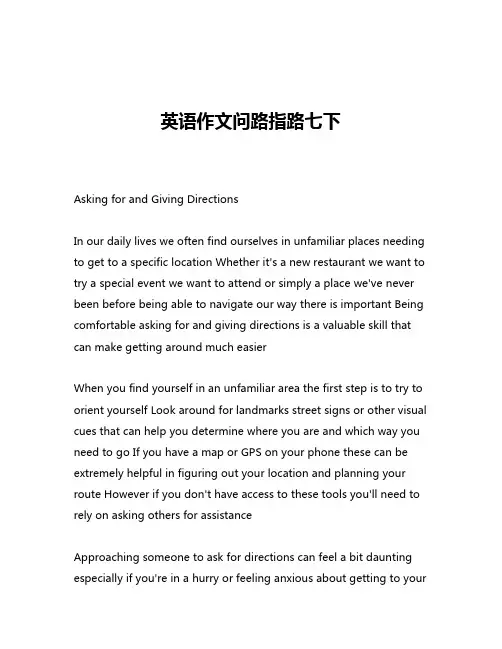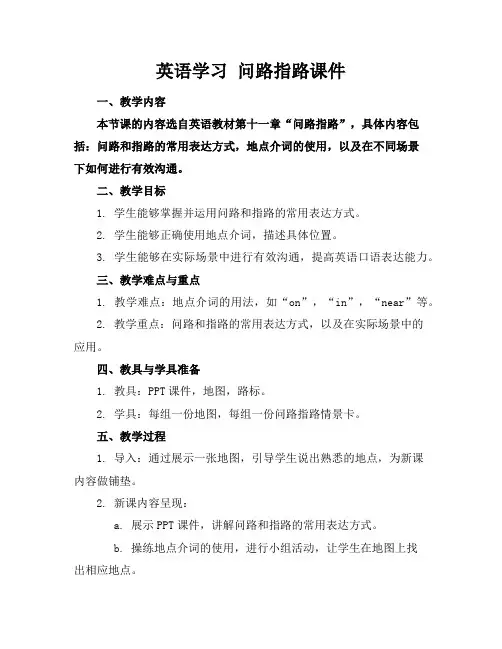福建省2015年初中英语微课一等奖——《英语问路指路的表达》
- 格式:ppt
- 大小:2.96 MB
- 文档页数:19





英语作文问路指路七下Asking for and Giving DirectionsIn our daily lives we often find ourselves in unfamiliar places needing to get to a specific location Whether it's a new restaurant we want to try a special event we want to attend or simply a place we've never been before being able to navigate our way there is important Being comfortable asking for and giving directions is a valuable skill that can make getting around much easierWhen you find yourself in an unfamiliar area the first step is to try to orient yourself Look around for landmarks street signs or other visual cues that can help you determine where you are and which way you need to go If you have a map or GPS on your phone these can be extremely helpful in figuring out your location and planning your route However if you don't have access to these tools you'll need to rely on asking others for assistanceApproaching someone to ask for directions can feel a bit daunting especially if you're in a hurry or feeling anxious about getting to yourdestination But try to remain calm and friendly when you ask for help The key is to be polite concise and clear in your request You might say something like Excuse me could you please tell me how to get to the main library from here or I'm trying to find the post office do you know the best way to get there from here Providing the person with your specific destination will help them give you more tailored directionsWhen asking for directions it's also important to listen carefully and ask for clarification if anything is unclear Don't be afraid to say I'm sorry I didn't quite catch that could you repeat the directions or Could you tell me one more time which way I should go from here Paying close attention and being willing to ask follow up questions will ensure you leave with the information you needOf course being on the other side of the exchange and providing directions to someone else is also an important skill Offering clear concise and easy to follow directions can make a big difference in helping someone reach their destination successfully When giving directions focus on landmarks and visual cues that will be easy for the person to identify Start by orienting them to where they currently are and then provide step by step guidance on how to get to their desired location You might say something like Okay soyou're standing in front of the bank right now Go down this street for two blocks and you'll see the library on your right hand side Turnleft at the stoplight and the post office will be straight ahead on the cornerIt's also helpful to gauge the person's familiarity with the area If they seem completely lost you may want to provide more detailed instructions If they seem somewhat familiar with the neighborhood you can likely give them a more condensed set of directions Pay attention to whether they seem to be understanding and following along and be willing to rephrase or clarify as neededIn addition to giving verbal directions consider offering to show the person on a map or providing written instructions if that would be more helpful Sometimes a visual aid can make a big difference in helping someone navigate successfullyNo matter which side of the exchange you're on staying patient calm and friendly is key Asking for and giving directions is a common everyday interaction but it can be stressful if not done well Taking the time to communicate clearly and ensure mutual understanding can go a long wayBeing able to ask for and provide directions is an important life skill that will serve you well no matter where your travels take you Whether you're new to an area or a long time resident being comfortable navigating and helping others do the same is invaluablePractice these techniques and you'll be directing people with confidence in no time。


英语学习问路指路课件一、教学内容本节课的内容选自英语教材第十一章“问路指路”,具体内容包括:问路和指路的常用表达方式,地点介词的使用,以及在不同场景下如何进行有效沟通。
二、教学目标1. 学生能够掌握并运用问路和指路的常用表达方式。
2. 学生能够正确使用地点介词,描述具体位置。
3. 学生能够在实际场景中进行有效沟通,提高英语口语表达能力。
三、教学难点与重点1. 教学难点:地点介词的用法,如“on”,“in”,“near”等。
2. 教学重点:问路和指路的常用表达方式,以及在实际场景中的应用。
四、教具与学具准备1. 教具:PPT课件,地图,路标。
2. 学具:每组一份地图,每组一份问路指路情景卡。
五、教学过程1. 导入:通过展示一张地图,引导学生说出熟悉的地点,为新课内容做铺垫。
2. 新课内容呈现:a. 展示PPT课件,讲解问路和指路的常用表达方式。
b. 操练地点介词的使用,进行小组活动,让学生在地图上找出相应地点。
3. 实践情景引入:a. 播放一段问路指路的视频,让学生观察并模仿。
b. 分组进行角色扮演,模拟实际场景,进行问路指路练习。
4. 例题讲解:针对问路指路的常用表达方式,给出例题,讲解解题思路。
5. 随堂练习:让学生根据所学内容,完成练习题,巩固知识点。
六、板书设计1. 问路和指路的常用表达方式。
2. 地点介词的用法。
3. 实践情景示例。
七、作业设计1. 作业题目:a. 根据所学内容,编写一段问路指路的对话。
b. 在地图上标出五个地点,并用所学介词描述它们的位置。
2. 答案:八、课后反思及拓展延伸1. 课后反思:本节课学生参与度较高,但在实践情景中,部分学生口语表达能力仍有待提高。
2. 拓展延伸:布置一道开放性作业,让学生结合所学内容,编写一段关于问路指路的短剧,下节课进行分享。
同时,鼓励学生在日常生活中用英语进行问路指路,提高实际应用能力。
重点和难点解析:1. 教学难点:地点介词的用法。
2. 实践情景引入:角色扮演,模拟实际场景。


福建省初中英语微课一等奖英语问路指路的表达》标题:《福建省初中英语微课一等奖:英语问路指路的表达》在我们的日常生活中,能够用英语进行基本的交流变得越来越重要。
今天,我将分享一段关于问路指路表达的英语微课,这段微课来自于福建省的初中英语比赛,并荣获了一等奖。
我们先来了解一下常用的问路和指路的英语表达。
当我们在英语中问路时,我们通常会使用“Excuse me, could you tell me how to get to the post office?”或者“Where is the nearest post office?”这样的表达方式。
而当我们给别人指路时,我们可能会说“Turn right at the next corner and then go straight for two blocks.”或者“You can take the subway to get there. The station is just around the corner.”在这段微课中,老师以生动有趣的方式引导学生们理解和使用这些基本的问路和指路表达。
他们通过角色扮演,模拟实际生活中的问路和指路场景,使学习变得更加互动和有趣。
福建省的这位老师凭借其独特的教学方法和深度互动,让微课的教学效果达到了极致。
她的课程设计富有创新,将语言学习与实际生活紧密相连,真正做到了让学生在轻松愉快的氛围中学习英语。
这段微课的成功也体现了福建省教育部门对于英语教育的重视。
他们积极推动英语教育的改革,强调英语的应用能力和交流能力的培养。
这种教育理念让学生们在享受学习的乐趣的也能提高他们的英语水平。
这段微课是福建省初中英语教育的一个缩影,也是我们学习英语问路指路表达的优秀资源。
我们可以通过观看和学习这段微课,提高我们的英语交流能力,同时也可以从中学习到一些优秀的教学方法和学习技巧。
让我们一起享受学习的乐趣,提高我们的英语水平吧!随着信息技术的快速发展,微课已成为一种新型的教学资源,被广泛应用于各学科的教学中。

英语学习问路指路课件一、教学内容本节课我们将学习教材《新视野英语》第二册第四章《问路指路》。
具体内容包括:问路的基本句型与词汇、指路的方向表达、常用地点名词和描述位置的介词。
二、教学目标1. 掌握问路和指路的基本句型,能够在实际场景中灵活运用。
2. 学会使用方向词和描述位置的介词,提高空间描述能力。
3. 增强英语口语交流能力,提高学习英语的兴趣。
三、教学难点与重点难点:问路和指路时的方向描述,以及不同场景下的句型运用。
重点:基本句型和词汇的掌握,以及在实际场景中的应用。
四、教具与学具准备1. 教具:PPT课件、地图、方向牌。
2. 学具:学生用书、练习册、笔记本。
五、教学过程1. 实践情景引入(5分钟)展示一段关于问路指路的视频,引导学生关注场景中的关键信息,激发学生兴趣。
2. 新课内容讲解(20分钟)(1)问路基本句型:介绍并板书常用的问路句型,如:Couldyou tell me the way to? How can I get to? 等。
(2)指路方向表达:讲解方向词,如:north, south, east, west, left, right等,以及描述位置的介词,如:near, between, opposite等。
(3)场景应用:结合教材实例,讲解在不同场景下如何运用所学句型和词汇。
3. 例题讲解(10分钟)针对本节课的重点内容,设计典型例题,进行讲解。
4. 随堂练习(15分钟)让学生分组练习,模拟问路指路的场景,巩固所学知识。
六、板书设计1. 问路基本句型2. 指路方向表达3. 常用地点名词和介词七、作业设计1. 作业题目:(1)根据所学内容,编写一段关于问路指路的对话。
(2)绘制一张地图,标注学校附近的地点,并用英语描述其位置。
2. 答案:八、课后反思及拓展延伸本节课结束后,教师应反思教学效果,关注学生的学习反馈,针对学生的掌握程度,进行拓展延伸。
如:组织学生进行实地问路指路活动,提高学生的实际应用能力。
